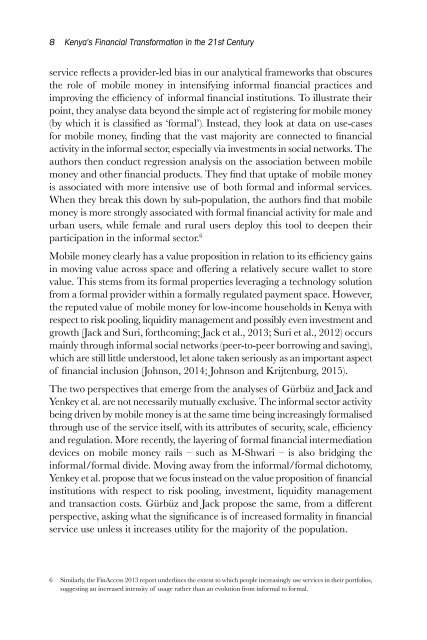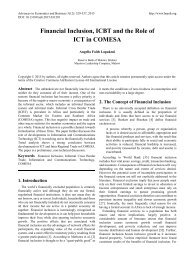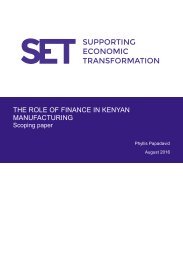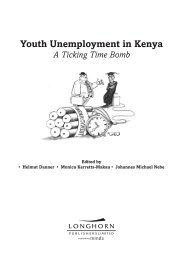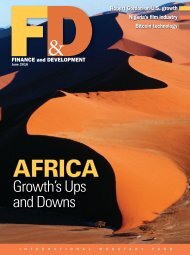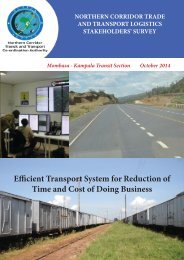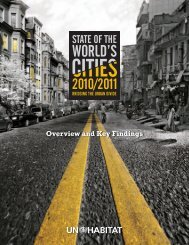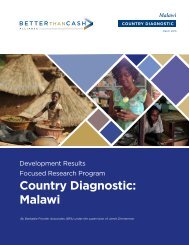in the 21st Century
hTOE305aYVW
hTOE305aYVW
You also want an ePaper? Increase the reach of your titles
YUMPU automatically turns print PDFs into web optimized ePapers that Google loves.
8 Kenya’s F<strong>in</strong>ancial Transformation <strong>in</strong> <strong>the</strong> <strong>21st</strong> <strong>Century</strong><br />
service reflects a provider-led bias <strong>in</strong> our analytical frameworks that obscures<br />
<strong>the</strong> role of mobile money <strong>in</strong> <strong>in</strong>tensify<strong>in</strong>g <strong>in</strong>formal f<strong>in</strong>ancial practices and<br />
improv<strong>in</strong>g <strong>the</strong> efficiency of <strong>in</strong>formal f<strong>in</strong>ancial <strong>in</strong>stitutions. To illustrate <strong>the</strong>ir<br />
po<strong>in</strong>t, <strong>the</strong>y analyse data beyond <strong>the</strong> simple act of register<strong>in</strong>g for mobile money<br />
(by which it is classified as ‘formal’). Instead, <strong>the</strong>y look at data on use-cases<br />
for mobile money, f<strong>in</strong>d<strong>in</strong>g that <strong>the</strong> vast majority are connected to f<strong>in</strong>ancial<br />
activity <strong>in</strong> <strong>the</strong> <strong>in</strong>formal sector, especially via <strong>in</strong>vestments <strong>in</strong> social networks. The<br />
authors <strong>the</strong>n conduct regression analysis on <strong>the</strong> association between mobile<br />
money and o<strong>the</strong>r f<strong>in</strong>ancial products. They f<strong>in</strong>d that uptake of mobile money<br />
is associated with more <strong>in</strong>tensive use of both formal and <strong>in</strong>formal services.<br />
When <strong>the</strong>y break this down by sub-population, <strong>the</strong> authors f<strong>in</strong>d that mobile<br />
money is more strongly associated with formal f<strong>in</strong>ancial activity for male and<br />
urban users, while female and rural users deploy this tool to deepen <strong>the</strong>ir<br />
participation <strong>in</strong> <strong>the</strong> <strong>in</strong>formal sector. 6<br />
Mobile money clearly has a value proposition <strong>in</strong> relation to its efficiency ga<strong>in</strong>s<br />
<strong>in</strong> mov<strong>in</strong>g value across space and offer<strong>in</strong>g a relatively secure wallet to store<br />
value. This stems from its formal properties leverag<strong>in</strong>g a technology solution<br />
from a formal provider with<strong>in</strong> a formally regulated payment space. However,<br />
<strong>the</strong> reputed value of mobile money for low-<strong>in</strong>come households <strong>in</strong> Kenya with<br />
respect to risk pool<strong>in</strong>g, liquidity management and possibly even <strong>in</strong>vestment and<br />
growth (Jack and Suri, forthcom<strong>in</strong>g; Jack et al., 2013; Suri et al., 2012) occurs<br />
ma<strong>in</strong>ly through <strong>in</strong>formal social networks (peer-to-peer borrow<strong>in</strong>g and sav<strong>in</strong>g),<br />
which are still little understood, let alone taken seriously as an important aspect<br />
of f<strong>in</strong>ancial <strong>in</strong>clusion (Johnson, 2014; Johnson and Krijtenburg, 2015).<br />
The two perspectives that emerge from <strong>the</strong> analyses of Gürbüz and Jack and<br />
Yenkey et al. are not necessarily mutually exclusive. The <strong>in</strong>formal sector activity<br />
be<strong>in</strong>g driven by mobile money is at <strong>the</strong> same time be<strong>in</strong>g <strong>in</strong>creas<strong>in</strong>gly formalised<br />
through use of <strong>the</strong> service itself, with its attributes of security, scale, efficiency<br />
and regulation. More recently, <strong>the</strong> layer<strong>in</strong>g of formal f<strong>in</strong>ancial <strong>in</strong>termediation<br />
devices on mobile money rails – such as M-Shwari – is also bridg<strong>in</strong>g <strong>the</strong><br />
<strong>in</strong>formal/formal divide. Mov<strong>in</strong>g away from <strong>the</strong> <strong>in</strong>formal/formal dichotomy,<br />
Yenkey et al. propose that we focus <strong>in</strong>stead on <strong>the</strong> value proposition of f<strong>in</strong>ancial<br />
<strong>in</strong>stitutions with respect to risk pool<strong>in</strong>g, <strong>in</strong>vestment, liquidity management<br />
and transaction costs. Gürbüz and Jack propose <strong>the</strong> same, from a different<br />
perspective, ask<strong>in</strong>g what <strong>the</strong> significance is of <strong>in</strong>creased formality <strong>in</strong> f<strong>in</strong>ancial<br />
service use unless it <strong>in</strong>creases utility for <strong>the</strong> majority of <strong>the</strong> population.<br />
6 Similarly, <strong>the</strong> F<strong>in</strong>Access 2013 report underl<strong>in</strong>es <strong>the</strong> extent to which people <strong>in</strong>creas<strong>in</strong>gly use services <strong>in</strong> <strong>the</strong>ir portfolios,<br />
suggest<strong>in</strong>g an <strong>in</strong>creased <strong>in</strong>tensity of usage ra<strong>the</strong>r than an evolution from <strong>in</strong>formal to formal.


